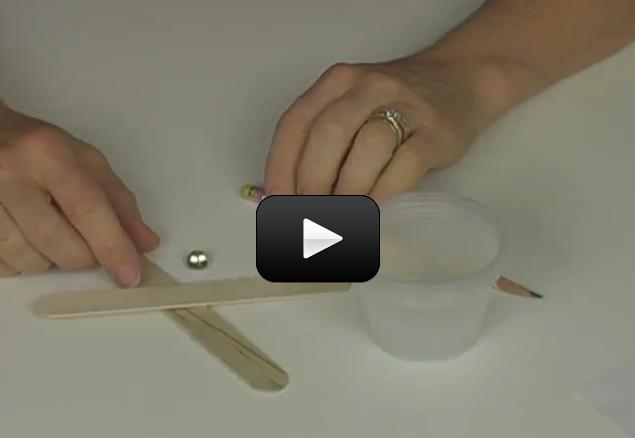Most weather stations have anemometers to measure wind speed or wind pressure. The kind of anemometer we’re going to make is the same one invented back in 1846 that measures wind speed. Most anemometers use three cups, which is not only more accurate but also responds to wind gusts more quickly than a four-cup model.
Some anemometers also have an aerovane attached, which enables scientists to get both speed and direction information. It looks like an airplane without wings – with a propeller at the front and a vane at the back.
Other amemometers don’t have any moving parts – instead they measure the resistance of a very short, thin piece of tungsten wire. (Resistance is how much a substance resists the flow of electrical current. Copper has a low electrical resistance, whereas rubber has a very high resistance.) Resistance changes with the material’s temperature, so the tungsten wire is heated and placed in the airflow. The wind flowing over the wire cools it down and increases the resistance of the wire, and scientists can figure out the wind speed.
Please login or register to read the rest of this content.


Sure thing!
can you use paper bowls instead of cups
There’s a couple of different ways to do this. The method described in the post has you put both anemometers in the wind so you can estimate the one whirling around with the protractor device. (It’s easiest if you color the bottom of one of the cups so you can count how many times it goes around in one minute.)
If you’d like a more accurate method of determining how to figure out how fast the cups are moving around the pencil, count how many times it goes around in a minute. Then measure the diameter (from a cup on one side to the cup on the opposite side).
Now we can calculate the circumference (the circular path that the cup takes). Say that I measure 6.5″ for a diameter, so multiply that by 3.14 to get 20.4 inches for the circumference. So every time one of the cups goes around once, it travels 20.4 inches. Divide this number by 12 to get a number in feet of 1.7 feet, which means it travels 1.7 feet every time it makes one revolution.
So how many feet did it travel in one minute? If I counted 178 revolutions per minute, multiply 1.7 feet by 178 revolutions to get 302.6 feet per minute. To get that in hours, multiply that number by 60 minutes to get 18,156 feet per hour, which you can convert to mph by dividing by 5,280 feet (that’s how many feet in a mile) to get 3.44 mph.
We built the anemometer with the 4 cups. How do you measure wind speed with it? There is no scale in the notes. I have instructions on using the ping-pong ball/protractor to measure wind speed. What am I missing? Thanks!
The easiest way is by sight… when you use the ping-pong-ball-protractor-measure-method (I should really post an image of this… I’ll see if I can get one posted soon!) then look at your other anemometer and you’ll see how fast it’s going on its own. It’s just a rough estimate, since making it more accurate involves a motor and a digital multi meter (something you get to do later in the program with other experiments).
how do you measure speed with the four cup model?
im gonna try this
Yes, look under the video for the experiment. If a worksheet is available, you’ll find a link for it there. There’s over 300 worksheets that you can print out.
We’re new to the program . . . are there worksheets for each experiment that my kids can fill out after doing the project?
You don’t add protractor to the anemometer – it’s a totally different design. We used to have a picture of it on that page… I am not sure where it went. Here’s a link to build your own.
With the ping-pong ball anemometer how do you add a protractor to the anemometer? It seems that the string would hit the protractor every 180 degres of a turn.
Thank you
Zachary
Sounds like fun. 🙂 How do you think you can fix it so that it works well?
when we blow in the 4 cup model the tack comes off of the eraser
Those are two DIFFERENT anemometers. You can have them side by side, but they work independently of each other.
Hi, I was just wondering how I could attach the ping-pong ball anemometer to the four cup anemometer.
Regards,
Aashman